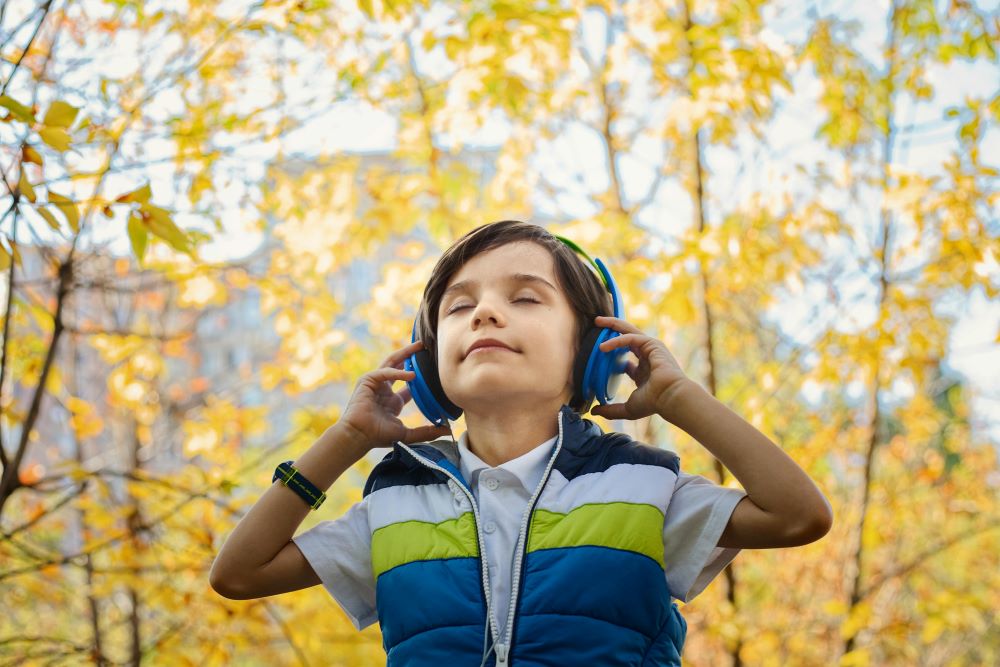New study finds earphones and other devices used to listen to music, podcasts and more could be permanently damaging children’s hearing.
A concerning trend has emerged among younger children, who may be permanently damaging their hearing by listening to loud music through earbuds and headphones. A recent report sheds light on the prevalence of this habit and its potential long-term consequences in kids’ ability to hear. According to the University of Michigan Health C.S. Mott Children’s Hospital National Poll on Children’s Health, two in three parents reveal that their children aged 5 to 12 frequently use listening devices. This includes half of children aged 5 to 8, exposing them to prolonged periods of loud noise at a remarkably young age, health experts caution.
Dr. Susan Woolford, a pediatrician at the University of Michigan, notes a shift in concern from teens to younger children regarding the overuse of audio devices. Earbuds, increasingly popular among the young demographic, subject children to intense noise regularly, raising alarms among health professionals.
The vulnerability of young children to noise-induced harm stems from their developing auditory systems and smaller ear canals compared to adults. Such factors amplify the perceived sound levels, heightening the risk of hearing damage.
Poll results indicate that half of parents report their children spending at least an hour daily using listening devices, with one in six children using them for two hours or more. Common settings for device use include home, school, and car rides, with occasional use during air travel and minimal use outdoors or in bed.

Recognizing the potential risks, the American Academy of Pediatrics issued a statement urging measures to reduce noise exposure in children, emphasizing the impact of prolonged or extreme noise on hearing and overall well-being. Dr. Woolford shows the irreversible nature of hearing loss resulting from damage to the delicate inner ear structures.
Excessive noise exposure in children can have far-reaching consequences beyond hearing impairment, extending into various aspects of their physical and mental well-being.
- Disrupted Sleep Patterns: Noise disruptions during sleep can interfere with the quality and duration of restorative sleep. Children exposed to high levels of noise may experience difficulties falling asleep, frequent awakenings during the night, and overall poor sleep quality. This disruption can lead to daytime fatigue, irritability, and difficulty concentrating, affecting their daily functioning and cognitive abilities.
- Hindered Academic Performance: Persistent exposure to loud noise can impair concentration and focus, making it challenging for children to engage effectively in learning activities. Noise distractions in educational settings, such as classrooms, can disrupt instruction and hinder students’ ability to absorb and retain information. Consequently, academic performance may suffer, impacting grades, comprehension, and overall educational attainment.
- Elevated Stress Levels: Constant exposure to noisy environments can trigger stress responses in children, contributing to heightened levels of anxiety and tension. Prolonged exposure to stress hormones, such as cortisol, may negatively impact physiological and psychological health, increasing the risk of various health problems over time. Chronic stress in children can manifest as emotional instability, behavioral issues, and reduced resilience to cope with everyday challenges.
- Impact on Blood Pressure: Studies suggest that exposure to environmental noise, including loud sounds from electronic devices, traffic, or industrial activities, may influence blood pressure regulation in children. Elevated noise levels can stimulate the body’s stress response, leading to fluctuations in blood pressure levels. Over time, persistent increases in blood pressure may contribute to cardiovascular health issues, including hypertension and related complications, posing long-term risks to children’s heart health.
The detrimental effects of excessive noise exposure extend beyond auditory impairment, including disruptions in sleep patterns, hindered academic performance, elevated stress levels, and potential impacts on blood pressure regulation.
Despite growing concerns, only half of parents have attempted to regulate their children’s device usage by implementing breaks, setting usage hours, or using timers. Notably, parents of children who use headphones for more than two hours daily are less likely to impose time or volume restrictions.
Dr. Woolford outlines several strategies for parents to mitigate noise exposure risks that could impact kids’ hearing. Monitoring volume levels and adhering to the “60/60” rule—limiting usage to 60 minutes per day at 60% of maximum volume—can safeguard children’s hearing. Additionally, parents should consider purchasing devices emitting less than 70 decibels and encourage device-free intervals to allow ears to rest.
Woolford advises against solely relying on products marketed as “kid-safe,” as not all restrict volume adequately. Parents should encourage alternative activities to protect their kids’ hearing, such as listening to music at lower volumes or engaging in screen-free time.
Concerned parents are encouraged to consult pediatricians, audiologists, or ear-nose-throat specialists for hearing evaluations and guidance on mitigating noise-related risks. Early detection of hearing loss signs, such as repeated requests for clarification or persistent ringing noises, can prompt timely interventions to preserve children’s hearing health.
Sources:
Earbuds, Headphones a Rising Threat to Kids Hearing
Impact on Hearing Due to Prolonged Use of Audio Devices: A Literature Review
Loud Music and Leisure Noise Is a Common Cause of Chronic Hearing Loss, Tinnitus and Hyperacusis


Join the conversation!